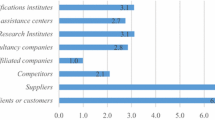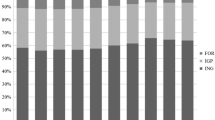Abstract
We investigate the determinants of research and development (R&D) cooperation in small and medium-sized enterprises (SMEs). Using firm-level data from the 2002 Korean Innovation Survey and applying a probit model with sample selection, we find that incoming spillovers of knowledge have a significant and positive impact on SMEs’ decisions to engage in R&D cooperation. In particular, the effect of knowledge spillovers on R&D cooperation is much larger for smaller firms. Despite the importance of external knowledge for SMEs, the estimation results suggest that SMEs may be at a disadvantage in establishing external R&D linkages because of their absolute size limitations.
Similar content being viewed by others
Notes
See Acs and Audretsch (1990) for an overview of factors affecting innovation activities in SMEs. Using the 2002 KIS and the Community Innovation Survey 2 (CIS2), Mun and Chun (2006) and Vaona and Pianta (2008) examine the relationship between firm size and innovation activities for Korean and European manufacturing firms, respectively.
For a recent survey on the role of SMEs in technological change, see Ortega-Argilés et al. (2009).
In addition to R&D cooperation as interfirm or interorganization contacts, Simonen and McCann (2008) examine face-to-face knowledge spillovers from labor acquisition.
Human resource and knowledge management can also be crucial factors determining firms’ absorptive capacity (Schmidt 2010).
The OECD Frascati Manual is a standard for surveys of R&D expenditures (input), whereas the Oslo Manual is a guideline for collecting data on innovation activities (output).
Under the Framework Act on SMEs in Korea, a company with fewer than 300 employees in the manufacturing sector is classified as an SME.
We exclude R&D cooperation within a Korean business group (so-called chaebol). Moreover, we use a business group dummy variable to estimate the determinants of R&D cooperation to control for possibly different behavior of firms affiliated with the business group.
In this paper, we define a firm as innovative if the firm is engaged in technological innovations. Thus, a firm is noninnovative if the firm conducts only nontechnological innovations. However, a research department can play a role in nontechnological innovations as well as technological innovations. Table 1 shows that 14.6% of noninnovative firms have research departments. These noninnovative firms with research departments might conduct only nontechnological innovations, which is also confirmed in the sample.
To obtain the four-digit-level three-firm concentration ratio, we aggregate the five-digit-level ratio published by the Korea Development Institute using the weights of the industry sales.
Korean standard industry classification (KSIC) codes include 21 two-digit-level manufacturing industries.
The bivariate probit model corrects for a possible sample selection bias and also provides more accurate estimates through the inclusion of noninnovative firms. In fact, the total sample size (2,190) is about twice as large as the number of innovative firms (1,043).
However, in a study of cooperative R&D behavior in Italian manufacturing firms by Piga and Vivarelli (2003), estimation results of the bivariate model with sample selection show that the correlation coefficient is positive but is not statistically significant.
The negative effect found in the study by López (2008) suggests that stronger legal protection may hamper internalization of knowledge flows and therefore decrease the probability of R&D cooperation.
Instead of the firm size dummy variable, we also tried to include the firm size variable (number of employees) together with the size-squared variable. The size variable is not significant at the 10% level in the simple probit model but is highly significant in the selection model. Firm size is reported to be significantly positive by Cassiman and Veugelers (2002) for Belgium and by Lee and Choe (2006) for Korea, but not by Abramovsky et al. (2005) for France, Germany, and the UK.
We are grateful to two anonymous referees for the suggestion that two different sources of bias should be distinguished: sample selection and simultaneity.
We use a two-step methodology in implementing IVs into the bivariate probit model with sample selection. The same two-step method is also used in Piga and Vivarelli (2004) in analyzing a firm’s decisions regarding internal and external R&D. A full-information maximum-likelihood estimator may be more desirable, but requires some fairly strong assumptions (Wooldridge 2002).
Definitions of basicness of R&D and length of product lives are described in the Appendix.
Since the model includes the three possible endogenous variables, we perform the joint test of the three residuals. Moreover, none of each coefficient of the first-stage residuals is statistically significant at the 10% level.
Consistently, Chun et al. (2007) find that incoming spillovers constitute a significant factor in determining cooperative R&D for firms in high-technology industries, but not in low-technology industries.
We are grateful to an anonymous referee for suggesting a possible multicollinearity problem.
In addition, Oh (2006) emphasizes trust among partners as an important factor determining the performance of R&D collaboration and shows that the free-riding problem is significantly reduced as the amount of firms’ investment in the R&D project increases.
Maximum values of VIF tests for Table 5 are less than 10, which indicates no multicollinearity problem.
References
Abramovsky, L., Kremp, E., López, A., Schmidt, T., & Simpson, H. (2005). Understanding co-operative R&D activity: Evidence from four European countries. Institute for Fiscal Studies Working Paper No. 05/23.
Acs, Z. J., & Audretsch, D. B. (1990). Innovation and small Firms. Cambridge, MA: MIT Press.
Acs, Z. J., Audretsch, D. B., & Feldman, M. P. (1994). R&D spillovers and recipient firm size. Review of Economics and Statistics, 76(2), 336–340.
Arundel, A. (2001). The relative effectiveness of patents and secrecy for appropriation. Research Policy, 30(4), 611–624.
Audretsch, D. B., & Vivarelli, M. (1996). Firms size and R&D spillovers: Evidence from Italy. Small Business Economics, 8(3), 249–258.
Bayona, C., García-Marco, T., & Huerta, E. (2001). Firms’ motivations for cooperative R&D: An empirical analysis of Spanish firms. Research Policy, 30(8), 1289–1307.
Belderbos, R., Carree, M., Diederen, B., Lokshin, B., & Veugelers, R. (2004). Heterogeneity in R&D cooperation strategies. International Journal of Industrial Organization, 22(8–9), 1237–1263.
Branstetter, L. G., & Sakakibara, M. (2002). When do research consortia work well and why? Evidence from Japanese panel data. American Economic Review, 92(1), 143–159.
Byma, J., & Leiponen, A. (2006). Can’t block, must run: Small firms and appropriability. ETLA Discussion Papers 1055.
Cassiman, B., & Veugelers, R. (2002). R&D cooperation and spillovers: Some empirical evidence from Belgium. American Economic Review, 92(4), 1169–1184.
Chatterjee, S., Hadi, A. S., & Price, B. (2000). Regression analysis by example (3rd ed.). New York: Wiley.
Chun, H., Mun, S.-B., & Yoon, Y. (2007). R&D cooperation in Korean ICT firms.” Sogang University Working Papers.
Cohen, W. M., & Levinthal, D. A. (1989). Innovation and learning: The two faces of R&D. Economic Journal, 99(397), 569–596.
Cohen, W. M., & Levinthal, D. A. (1990). Absorptive capacity: A new perspective on learning and innovation. Administrative Science Quarterly, 35(1), 128–152.
d’Aspremont, C., & Jacquemin, A. (1988). Cooperative and noncooperative R&D in duopoly with spillovers. American Economic Review, 78(5), 1133–1137.
Dodgson, M. (1993). Technological collaboration in industry: Strategy, policy and internalization in innovation. London: Routledge.
Freel, M. S. (2007). Are small innovators credit rationed? Small Business Economics, 28(1), 23–35.
Fritsch, M., & Lukas, R. (2001). Who cooperates on R&D? Research Policy, 30(2), 297–312.
Greenlee, P., & Cassiman, B. (1999). Product market objectives and the formation of research joint ventures. Managerial and Decision Economics, 20(3), 115–130.
Hagedoorn, J. (1993). Understanding the rationale of strategic technology partnering: Interorganizational modes of cooperation and sectoral differences. Strategic Management Journal, 14(5), 371–385.
Hagedoorn, J., Link, A. N., & Vonortas, N. S. (2000). Research partnerships. Research Policy, 29(4–5), 567–586.
Hall, B. H. (2002). The financing of research and development. Oxford Review of Economic Policy, 18(1), 35–51.
Kamien, M. I., Muller, E., & Zang, I. (1992). Research joint ventures and R&D cartels. American Economic Review, 82(5), 1293–1306.
Katz, M. (1986). An analysis of cooperative research and development. Rand Journal of Economics, 17(4), 527–543.
Kesteloot, K., & Veugelers, R. (1995). Stable R&D cooperation with spillovers. Journal of Economics and Management Strategy, 4(4), 651–672.
Kitching, J., & Blackburn, R. (1999). Intellectual property management in the small and medium enterprise (SME). Journal of Small Business and Enterprise Development, 5(4), 327–335.
Lee, K., & Choe, B. (2006). An empirical study on the determinants of R&D cooperation. Korean Journal of Industrial Organization, 14(4), 67–102.
López, A. (2008). Determinants of R&D cooperation: Evidence from Spanish manufacturing firms. International Journal of Industrial Organization, 26(1), 113–136.
Miotti, L., & Sachwald, F. (2003). Co-operative R&D: Why and with whom? An integrated framework of analysis. Research Policy, 32(8), 1489–1499.
Mun, S.-B., & Chun, H. (2006). Determinants of innovation activities in Korean ICT firms. Review of Applied Economics, 8(1), 145–164.
Nooteboom, B. (1994). Innovation and diffusion in small firms: Theory and evidence. Small Business Economics, 6(5), 327–347.
OECD, & Eurostat. (1997). Oslo manual: Proposed guidelines for collecting and interpreting technological innovation data (2nd ed.). Paris: OECD.
Oh, J.-B. (2006). R&D collaboration: An empirical study of the government sponsored R&D program. Korean Journal of Industrial Organization, 14(3), 111–146.
Ortega-Argilés, R., Vivarelli, M., & Voigt, P. (2009). R&D in SMEs: A paradox? Small Business Economics, 33(1), 3–11.
Piga, C. A., & Atzeni, G. (2007). R&D investment, credit rationing and sample selection. Bulletin of Economic Research, 59(2), 149–178.
Piga, C. A., & Vivarelli, M. (2003). Sample selection in estimating the determinants of cooperative R&D. Applied Economics Letters, 10(4), 243–246.
Piga, C. A., & Vivarelli, M. (2004). Internal and external R&D: A sample selection approach. Oxford Bulletin of Economics and Statistics, 66(4), 257–482.
Rammer, C., Czarnitzki, D., & Spielkamp, A. (2009). Innovation success of non-R&D-performers: Substituting technology by management in SMEs. Small Business Economics, 33(1), 35–58.
Rothwell, R., & Dodgson, M. (1991). External linkages and innovation in small and medium-sized enterprises. R&D Management, 21(2), 125–138.
Sakakibara, M. (1997). Heterogeneity of firm capabilities and cooperative research and development: An empirical examination of motives. Strategic Management Journal, 18(S), 143–165.
Schmidt, T. (2010). Absorptive capacity-one size fits all? A firm-level analysis of absorptive capacity for different kinds of knowledge. Managerial and Decision Economics, 31(1), 1–18.
Simonen, J., & McCann, P. (2008). Innovation, R&D cooperation and labor recruitment: Evidence from Finland. Small Business Economics, 31(2), 181–194.
Stock, J. H., & Yogo, M. (2005). Testing for weak instruments in linear IV regression. In D. W. K. Andrews & J. H. Stock (Eds.), Identification and inference in econometric models: Essays in honor of Thomas J. Rothenberg (pp. 80–108). Cambridge: Cambridge University Press.
Tether, B. S. (2002). Who co-operates for innovation, and why: An empirical analysis. Research Policy, 31(6), 947–967.
Vaona, A., & Pianta, M. (2008). Firm size and innovation in European manufacturing. Small Business Economics, 30(3), 283–299.
Wooldridge, J. M. (2002). Econometric analysis of cross section and panel data. Cambridge, MA: MIT Press.
Acknowledgments
We are most grateful to the associate editor Marco Vivarelli and two anonymous referees for valuable comments. We would also like to thank Jungsoo Park and participants in the Comparative Analysis of Enterprise Data (CAED) Conference and the Western Economic Association Conference for their helpful comments, and the Science and Technology Policy Institute (STEPI) for providing the 2002 Korean Innovation Survey dataset. Chun gratefully acknowledges the financial support from the Sogang University Research Fund.
Author information
Authors and Affiliations
Corresponding author
Appendix
Rights and permissions
About this article
Cite this article
Chun, H., Mun, SB. Determinants of R&D cooperation in small and medium-sized enterprises. Small Bus Econ 39, 419–436 (2012). https://doi.org/10.1007/s11187-010-9312-5
Accepted:
Published:
Issue Date:
DOI: https://doi.org/10.1007/s11187-010-9312-5




